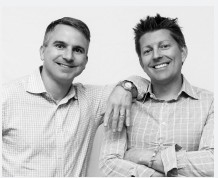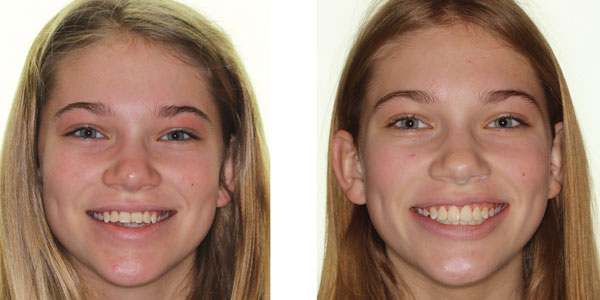Drs. Todd Bovenizer and Christopher Baker discuss brackets that offered precise control for efficient treatment
As we reopen our offices, treatment efficiency will be more important than ever. If we can get patients out of treatment faster and in fewer visits, we will be able to keep our patients, our staff, and their families safe while maximizing our practice throughput. The excellent control that the Damon Q2 bracket provides, due to enhanced rotation control and variable torque brackets, is helping to significantly improve our practice efficiency. The following simple case that we all encounter illustrates how effective bracket prescription and stainless steel (SS) mechanics can drive good results and efficiency. We achieve that efficiency by selecting the proper variable torque Damon Q2 brackets, using bite turbos to disarticulate the occlusion, prescribing early light elastics, and of course, using high-tech copper nickel-titanium archwires. All of this is done using simple treatment mechanics, resulting in a highly efficient esthetic finish, and making sure that the health and safety of the patient is paramount.
Patient “RH” presented to our office at a young age when we applied tongue tamers to aid in correct tongue position. She was in our growth and development program until comprehensive care started. Our biggest concern was the open-bite tendency and exacerbating this with treatment as we often can do. We therefore estimated 16 to 18 months of total treatment time.
Diagnosis
RH was 13½ years old when we initiated orthodontic care. We prefer permanent dentition, including 12-year molars, and we like to treat during adolescence to utilize growth when needed. She presented with a Class I skeletal and dental. There was mild maxillary and moderate mandibular crowding. She had minimal overbite and mild overjet. Again, our biggest concern was the open-bite tendency, and to further complicate this, her maxillary and mandibular incisors were proclined slightly.
Figure 1: Initial photos, ceph, and pan
Objectives
One of our top treatment goals was to increase the inter-incisal angle by uprighting the patient’s incisors and therefore gaining more overbite for functional anterior guidance.

Figure 2: After bonding photos
Case progression
Appointment 1: We selected our variable torque prescription with our treatment goals in mind. We bonded her U/L 6-6 with low-torque Damon Q2 on the maxillary and mandibular incisors. We placed bite turbos on the mandibular 6s, placed 0.014 CuNiTi wires, and began Quail delta elastics and an anterior box with a Parrot (Ormco Zoo Pack Elastics).
Appointment 2: 10 weeks into treatment, we bonded U/L 7s and placed 0.018 CuNiTi wire and kept same elastic pattern.
Appointment 3: 4 months into treatment, we placed U/L 0.14 x 0.025 CuNiTi, kept same elastics, and scheduled progress pan and repositions for 8 weeks out.
Appointment 4: 6 months into treatment, no repositions were deemed necessary, and we moved into stainless steel (SS) wires: 0.19 x 0.025 SS on upper and 0.16 x 0.025 SS on lower. Trillium hooks were placed on the wire, and tiebacks were used to keep space closed. One elastic was used — an anterior box with a Zebra (Ormco Zoo Elastics) tied to the posts and not the teeth on the maxillary wire. Take note here that the patient’s overbite was not sufficient, and the incisors were still a little proclined. Our plan was to manipulate her wires by expanding the posterior to upright the anterior. We also planned interproximal reduction (IPR) with sling chain to aid in uprighting the incisors.
Appointment 5-8: Manipulation of the wires to expand and IPR with sling chain (power chain run under the wire and to torque the incisors in under the brackets in the anterior).
We did not bend wire in these detailing appointments. We used an archwire grid from Ormco at each SS wire appointment. The doctors coordinated, expanded, and contracted the wires as needed, based on clinical observations. IPR was completed once on the lower 2-2. We used a settling elastic protocol with Kangaroo elastics 3/16, 4 oz. (Ormco Zoo Pack Elastics).
Appointment 9: 12 months into treatment — debond, removal of appliances.

Figure 3: Progress photos and pan

Figure 4: Progress photos

Figure 5: Debond photos, ceph, and pan
Summary
We have really enjoyed the increased control of the Damon Q2 appliances. We have always enjoyed the passive self-ligation for early light elastics and arch from development. There is also a degree of “slop” that we have always appreciated when interdigitating the teeth together. That was why we finished in a lower 0.16 x 0.025 SS. The photos presented here were the actual photos taken at debond, which is what we always do. They display how the orthodontist was able to finish the occlusion. With patient RH, we enjoyed that little bit of extra control in how we were able to control the maxillary and mandibular incisor position. We were very pleased with the overbite for anterior guidance and also the inter-incisal angle that was controlled with treatment. Lastly, this treatment took us nine appointments from start to finish. The majority of these appointments occurred in SS wires.
Conclusion
We have successfully addressed the patient’s chief complaint for seeking treatment and have exceeded our treatment objectives for the case. Most surprising to us was the treatment time of 12 months. This was 4 to 5 months ahead of anticipated finish. We attribute this to the efficiencies that the Damon Q2 bracket brings to our practice, allowing us to achieve excellent rotational control for improved precision, predictability, and reliability. Using variable torque options with the Damon Q2 bracket reduces our total treatment time and overall appointments, because it allows for quicker coupling and when chosen correctly can make up for the “slop” that all brackets exhibit in the slot. We pick the appropriate torque during treatment planning when we forecast the impacts of our treatment mechanics. Picking the appropriate torque at the outset allows us to stay out of poor torque situations that will need to be corrected later in treatment. Overall, the Damon Q2 bracket allows us to treat cases with the precise control we require, so we can finish cases efficiently while using simple mechanics.
 Todd Bovenizer, DDS, graduated from Virginia Tech with his Bachelor of Science in Biology and from West Virginia with his Master’s in Orthodontics and Doctor of Dental Surgery. He is a Board-certified orthodontist from the American Board of Orthodontics. Dr. Bovenizer is part of Damon’s Mentor Program and lectures nationally on the Damon® System. He serves on the Ormco™ Insider’s Group Product Development Team, where he meets with top clinicians to discuss product research and development. Outside of orthodontics, Dr. Bovenizer spends his time with his wife, Megan, and their three wonderful young girls.
Todd Bovenizer, DDS, graduated from Virginia Tech with his Bachelor of Science in Biology and from West Virginia with his Master’s in Orthodontics and Doctor of Dental Surgery. He is a Board-certified orthodontist from the American Board of Orthodontics. Dr. Bovenizer is part of Damon’s Mentor Program and lectures nationally on the Damon® System. He serves on the Ormco™ Insider’s Group Product Development Team, where he meets with top clinicians to discuss product research and development. Outside of orthodontics, Dr. Bovenizer spends his time with his wife, Megan, and their three wonderful young girls.
Christopher Baker, DDS, is a Board-certified orthodontist from the American Board of Orthodontics. He serves as Vice President of the North Carolina Association of Orthodontists and is the North Carolina Political Outreach Leader for the American Association of Orthodontists Political Action Committee (AAOPAC). His father is a retired orthodontist and previously had practices in southern Indiana and Hilton Head Island, South Carolina. Dr. Baker and his wife, Brooke, have two sons, Cooper and Cruz Duke. When not doing orthodontics or working on patients, the Bakers love traveling, especially around the islands of the Caribbean.
Disclosure: Dr. Bovenizer is a paid consultant for Ormco™.


